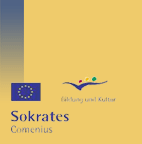|
Where? a
group-area that can be blacked out
|
How long? Approx. 45
minutes
|
What? Experiment concerning the topic Light and Seeing
|
|
Preparation:
Material:
Bulb vase,
Kleenex, magnifying glass, torch, play dough, scissors, Scotch tape
|
Steps:
Situation /
Problem:
What do we need in order to see an object or catch it with a camera?
In a blacked out room the children experiment with a torch to find out when
an object or a person becomes visible. Who can see: the child who holds the
torch or the child who the spotlight is fixed on?
Exploring-discovering
Phase:
The
children build a model of the human eye by using a bulb vase, some Kleenex, a
magnifying glass and play dough.
They cut a figure out of cardboard paper and put it in front of before
the magnifying glass. The room is blacked out. The figure is lit up with the
torch. The children realize that the projected picture is upside down and
blurred. They turn the figure upside down and watch what happens. They try to
get a sharper picture by moving the magnifying glass. They compare it with
the lens of a reflex camera.
|











